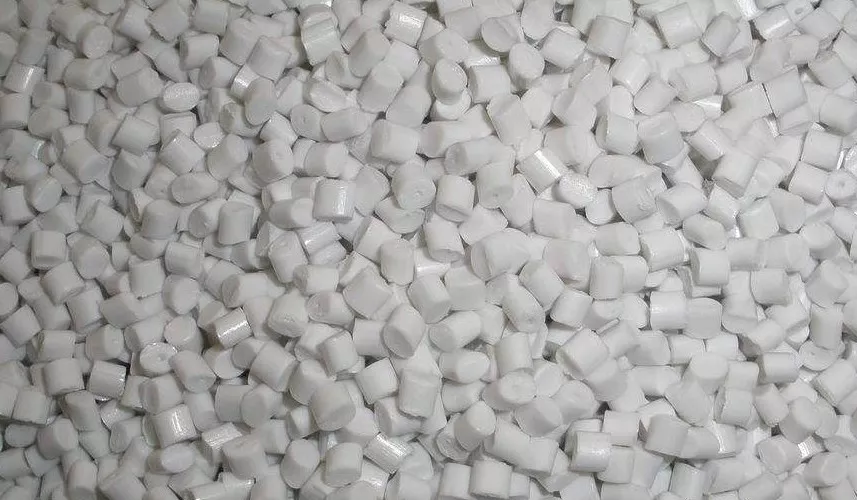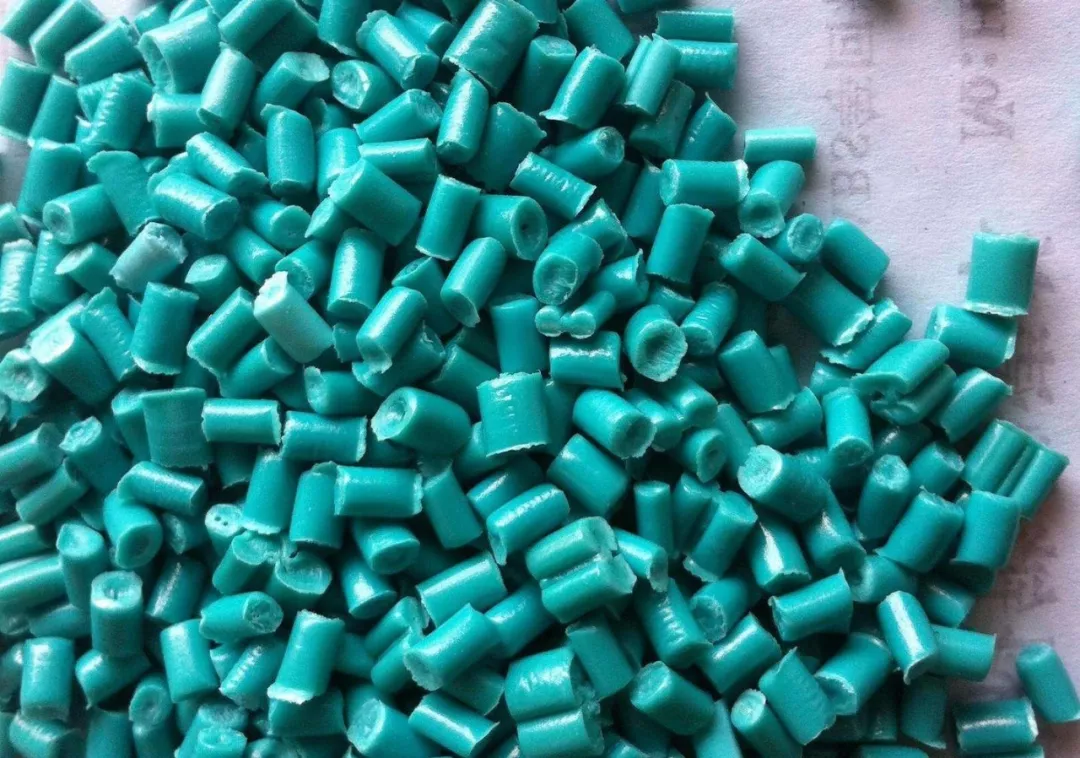We will further discuss and analyze the problems of continuous grain, tailing material, and hollow material encountered in processing.
Pellet Chain
A series of pellets that adhere to each other is usually called a duplex or pellet chain.
The reason may be that the processing water temperature is too high or the water flow velocity is too low.
During the processing, several process problems may individually or jointly cause this phenomenon to occur. For example, too hot processing water is a cause of contiguous particles. In this case, the water temperature should be lowered to give enough quenching to the particle surface. Besides, the low water flow rate is also a cause of continuous granulation, which will cause the particle cutting chamber to slow down and particle agglomeration. Also, if the holes of the die are too close, the expansion of the outlet will cause particle contact during the processing. The solution is to replace the existing die with a die with a large spacing and a small number of holes.

Tailing Problem
The so-called tailing means that the edges of the particles are somewhat protruding, like a broom tail-like shape. The reason for this is that the cutting device fails to make a clean cut here.
For the strand cutting production line, the solution is to replace the hob and bedknife to provide a new and sharp cutting edge; or re-determine the equipment spacing according to the value specified in the manufacturer's manual. For underwater pelletizing system, the template and blade need to be checked to ensure that there are no nicks, because nicks and grooves often cause tailing.
Powder Problem
For many crystalline materials, such as general-purpose polystyrene, powder is often produced when pelletizing. This problem can generally be solved by adjusting the equipment process parameters. When the extruded material enters the cutter, the temperature of the line should be slightly lower than or close to the Vicat softening point to ensure that the material is cut as hot as possible to avoid breakage.
For a specific polymer, choosing a hob with an appropriate cutting angle can also have a significant effect on reducing the amount of material. For polymers that are not filled with fillers, use Stellite alloy steel or tool steel hobs as much as possible, and keep the hob and bedknife edges sharp to avoid breaking the polymer. For the subsequent equipment after pelletizing, no matter it is pressurized or vacuum equipment, it is necessary to avoid entrapment of air.
For the underwater pelletizing line, it is necessary to maintain sufficient knife pressure against the die surface during processing, and adjust the residence time after pelletizing appropriately to ensure that the particles are hot when they enter the dryer.
Strip Drift Problem
Strip drift is the phenomenon that the strands are bunched to one side on the feeding platform. It will cause problems such as poor quality of the material, slenderness and processing disorder. If the cutting plane of the pelletizer is not parallel to the extruder template, the strands will tend to crowd to the left or right, which will eventually cause the strip to drift. Besides, other reasons for strip drift include the inconsistent gap between the lower feeding roller and the doctor blade, and the inconsistent diameter of the lower feeding roller.
Hollow Problem

1. Poor Exhaust
Poor exhaust (or steam): Due to poor natural exhaust or vacuum exhaust. It may be that the material itself contains water vapor, or it may be the water vapor decomposed by additives such as flame retardants. It is also possible that the vacuum is blocked or the vacuum is too small or leaks or the vacuum gasket is too high, etc., which causes the presence of gas (vapor) in the particles to form a hollow material.
2. Poor Plasticization
The processing temperature is low, the material is not completely plasticized, the lighter (small holes) will cause the particles to be hollow, and the heavy ones (large holes) will cause broken bars.
Too many low-melting additives (including EBS or PETS), if the screw shear is weak, it will form a hollow material due to poor plasticization of the material.
3. The Water Temperature Is Too Low
If the cooling water temperature is too low, the material will shrink when exposed to water, causing shrinkage holes, such as PP products-this kind of phenomenon is mainly for crystalline plastics. Generally, crystalline plastics (such as PP, PA, PBT, etc.) should use low water temperature, and non-crystalline plastics (such as ABS, PC/ABS, HIPS, etc.) should use high water temperature.
Flattening Problem

The problem of deflation or flattening of the material particles indicates that there is a shrinkage gap, which is caused by improper shrinkage of the material strip.
Shrinkage voids and hollow pellets indicate improper tempering of the strip. When the shrinkage gap is slight, it may just be a small pit on the end face of the particle, but when it is severe, hollow particles may be produced. This phenomenon occurs when the temperature of the core of the strip is close to the molten state, and the cooling water temperature is too low, the outer surface of the strip is rapidly cooled, resulting in a hard shell, and the heat is left in the core of the strip. Besides, the strips do not have enough time to soak in air or water, resulting in that the heat from the core of the strands cannot be transferred to the surface of the strands, so that good cross-sectional cooling cannot be performed, which can also cause this phenomenon.
Particles produced by underwater pelletizing will also have shrinkage voids due to the trapped volatiles in the melt. An effective preventive measure is to check the vacuum holes on the extruder.
Material Feeding from Natural Exhaust Port And Vacuum Port
Material from Natural Exhaust Port:
The feeding speed does not match the speed of the main engine. Reduce the feeding speed or increase the speed of the main engine.
The temperature from the feeding section to the area contained in the natural exhaust port is too low, and the material is not plasticized. Under the action of screw extrusion, raw material is emitted.
The temperature near the natural exhaust port is too high, and the viscosity of the material drops seriously. The screw in this section is slippery, and the material cannot be transported to the front section in time. Under the action of subsequent material flow extrusion, clinker is emitted.
The position of the natural exhaust port of the screw does not match the position of the natural exhaust port of the barrel, resulting in material loss. Generally, because there is no reverse conveying element or reverse engagement block, the pressure of the natural exhaust port groove can not be reduced, and the subsequent material flow will cause material to be off.
Vacuum Port Feeding:
The vacuum draw force is too large, and the material is sucked into the vacuum pipe, causing material to be exposed.
The screw vacuum position is not equipped with reverse conveying elements or reverse engaging blocks, which cannot reduce the pressure of the screw groove in the vacuum section, which will cause material to be ejected under the action of vacuum.
The temperature in the vacuum section is too high, the viscosity of the material drops seriously, the screw in this section is slippery, and the material cannot be transported to the front section in time. Under the action of the vacuum, the material will be exposed.
The extrusion processing temperature is too low, the material is not plasticized or the flame retardant and other additives are not fully dispersed in the resin, which will cause the material to be ejected under the action of the vacuum.
The screw combination is also reasonable, the position is also matched, and the temperature, the main engine and the feeding speed are also matched, the vacuum gasket is low, and the material is ejected under the action of material flow extrusion and vacuum suction.
Too much pressure on the machine head (causes include: clogging of the die, too much filter, too low temperature of the machine head, etc.), increasing backflow, and material ejection under the action of vacuum.
Hopper Bridge
Too much filler, moisture absorption, and agglomeration will increase the friction between the mixture and the hopper wall. Adding "white oil" and other liquid lubricants to reduce the friction between the mixture and the hopper wall and the mixture can solve this problem.
The mixture is agglomerated (including high temperature agglomeration and agglomeration due to excessive addition of liquid additives). It is necessary to reduce the drying temperature or high mixing time and reduce the amount of liquid additives. Adding powdered resins or additives (such as high rubber powder, AS powder, PP powder, etc.) that can absorb "oily" substances can solve this problem.
Sometimes bridging problems also occur at the feeding port. This is generally due to the low melting point of certain processing aids. The processing temperature in the first and second zones is too high, and the material softens at the bottom of the feeding silo and adheres to the equipment wall, which makes subsequent feeding difficult. This problem can be solved by appropriately lowering the processing temperature in zone one and zone two.
The processing of recycled materials is much more difficult than the processing of new materials, and various complex problems will also be encountered during the granulation process. These problems are scattered, but they can generally be solved by adjusting process parameters or equipment. If you are unclear, you can contact our company's experts to serve you wholeheartedly.
Do you now know how to solve common problems in waste plastic granulation? Chuangbo is a professional twin screw extruder manufacturer and supplier in China. We can provide customers with different extruders with excellent performance, such as masterbatch extruder, PVC compounding, thermoplastic elastermor, reaction extrusion line, devolatilization extruder, pelletizing system, etc.





